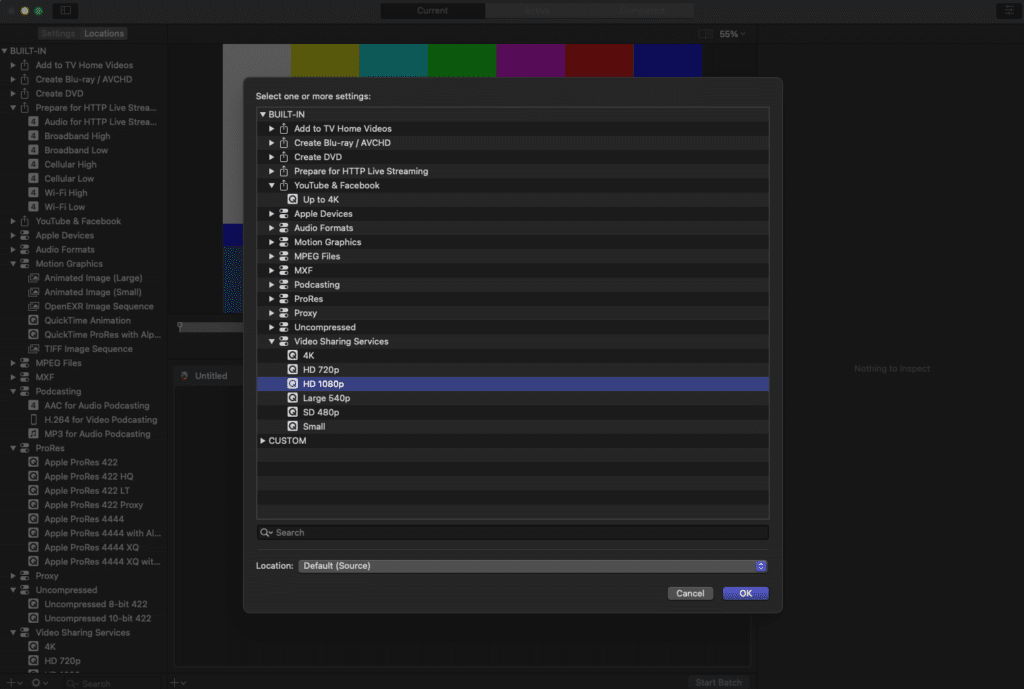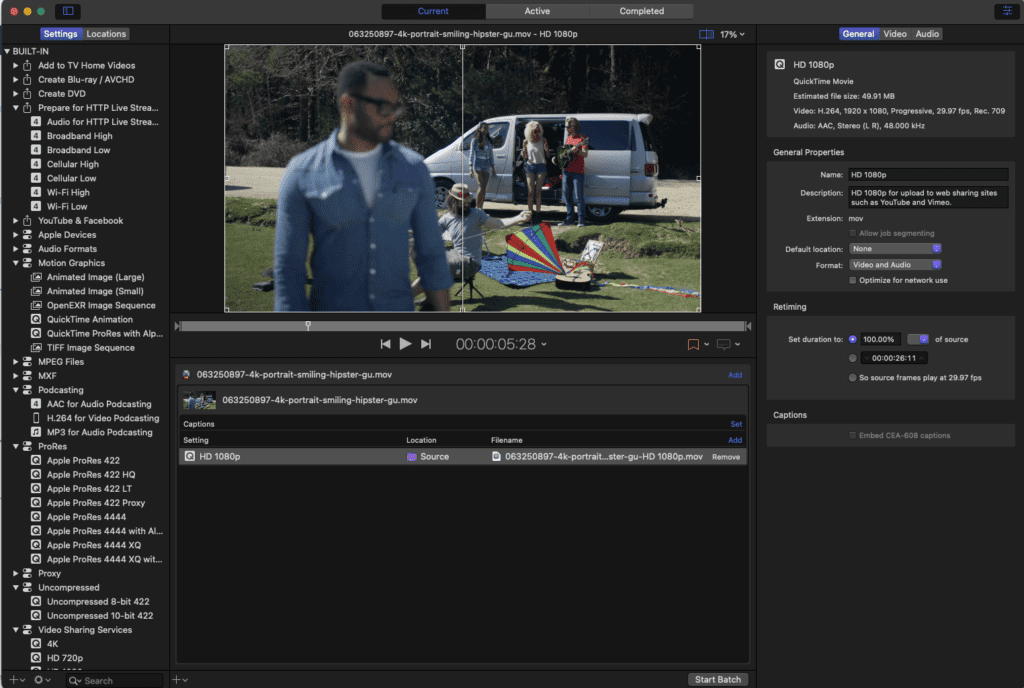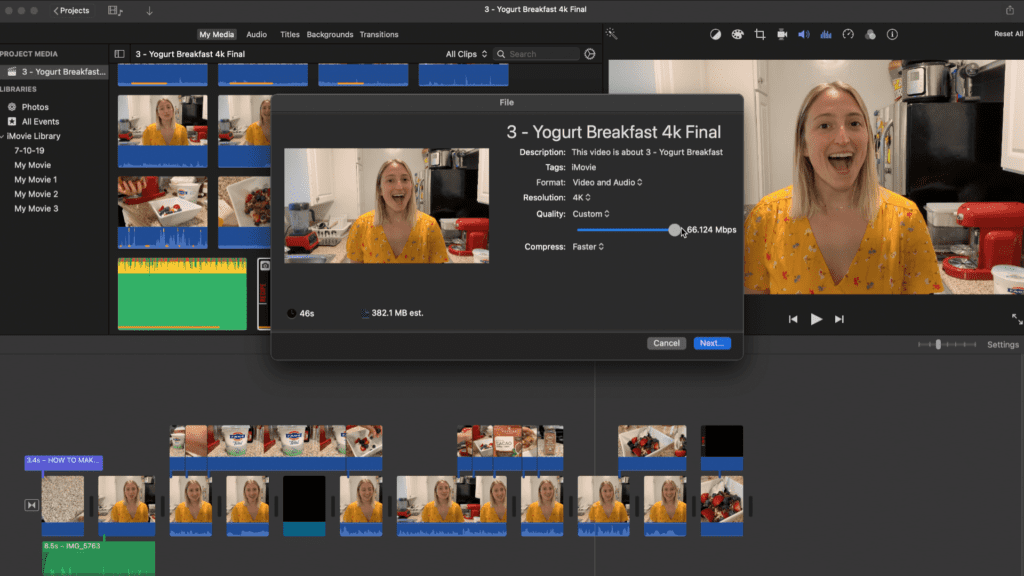What Video Formats Can Be Uploaded to Flickr?
Y'all've spent many hours, and mayhap thousands of dollars on high-quality cameras and computers, shooting and editing your latest YouTube video. The final thing you want is for all that work to go to waste product because your project exported too compressed and pixelated.
Don't worry; we've got you covered. Whether yous're uploading a video for your business, vlog, or passion, in this guide, we'll comprehend everything y'all demand to know virtually exporting and uploading videos to YouTube, including:
- The best settings to consign to YouTube
- What files and specs YouTube accepts
- Common questions most uploading different files to YouTube
What types of files can yous upload to YouTube?
The following are file formats supported for upload to YouTube:
- .MOV
- .MPEG4
- .MP4
- .AVI
- .WMV
- .MPEGPS
- .FLV
- 3GPP
- WebM
- DNxHR
- ProRes
- CineForm
- HEVC (h265)
MOV, MP4, and AVI are the nigh common types of files you'll use.
Your video editing software should exist able to export to 1 of the above YouTube video upload formats. If you have an existing file that you're trying to convert, various encoding apps can as well aid you convert audio and video files. Nosotros accept some suggestions below.
What is the difference between video file containers and video codecs?
A video codec is the method used to compress and decompress the video. Raw video and audio take a lot of storage space; therefore, video codec compresses the data making it easier to shop information technology. The about common types of codec used these days are H.264 and MPEG.
The video file container stores the video file and related media. Subsequently the codec compresses the file, you can store it in a video file container. Some popular types of video file containers include MOV, MP4, AVI, VOB, and MKV.

YouTube Recommended Encoding Specifications
For optimum performance, YouTube recommends specific encoding settings for exporting and uploading your media. These YouTube video upload specs offering information regarding the recommended video container, video codec, audio codec, frame rate, bitrate, resolution & aspect ratio, and colour space.
While other upload specifications and settings volition besides work, reduced settings may produce a lower quality video, such as pixelation and done-out colors.
Recommended Settings for Standard Dynamic Range (SDR) Videos
| Container | MP4 |
| Video Codec | H264 |
| Sound Code | AAC-LC in Stereo or 5.1 surround, with a sample charge per unit of 96khz or 48khz |
| Frame Rate | Aforementioned frame rate as recorded, normally 24, 25, 30, or 60 FPS |
| Bitrate | 4K Videos: 35-45 Mbps 1080 HD Videos: 8 Mbps |
| Resolution | 4K: 3840 x 2160 Hd: 1920 x 1080 Export at the setting most of your video was shot in |
| Aspect Ratio | sixteen:9 (YouTube will automatically letterbox anything not uploading in this ratio) |
| Color Space | BT or Rec 709 |
Recommended Settings for High Dynamic Range (HDR) Videos
YouTube currently supports HDR videos. HDR is a special format that accommodates a wider set of colour information, producing more than vibrant images. Simply it'southward merely bachelor when shooting with supported cameras and edited in software that supports HDR. If you're not sure if your video is HDR, it most probable is SDR (Standard Dynamic Range).
| Container | MOV MP4 MKV |
| Video Codec | H.264 ten bitVP9 Profile 2ProRes 422ProRes 4444DNxHR HQX |
| Sound Code | AAC-LC in Stereo or 5.one surround, with a sample charge per unit of 96khz or 48khz |
| Frame Rate | Same frame rate equally recorded, usually 24, 25, 30, or 60 FPS |
| Bitrate | 4K Videos: 44-56 Mbps 1080 Hd Videos: 10 Mbps |
| Resolution | 4K: 3840 ten 2160 Hard disk: 1920 x 1080 Export at the setting almost of your video was shot in |
| Aspect Ratio | 16:9 (YouTube volition automatically letterbox anything not uploading in this ratio) |
| Color Space | BT or Rec 709 |
Read this for more on HDR requirements on YouTube.
All-time Quality Export Settings for YouTube Video

While the above is YouTube'due south recommended settings, if your software and internet speed support it, there are a few means to get fifty-fifty higher quality video uploaded to YouTube.
YouTube'due south max file size limit is 128 GB – large enough to handle professional-grade codecs. And then if you have the speed to support it, hither are our recommended max settings.
But keep in mind, your terminal output is only as skilful every bit your source video. Exporting at a higher setting than the video you shot won't magically make your video college quality.
All-time Settings for 1080p Hard disk drive Videos
File: MOV
Format: ProRes 422
Dimensions: 1920 x 1080p
Frame Rate: Aforementioned as recorded
Bitrate: 12 Mbps+ You may also use two-pass variable bitrate, VBR 2-pass, where available.
Audio file format: AAC
Best Settings for 4K Videos
With some exceptions, you can utilise a similar setting for 4K videos. Here is a general guideline to get the best quality:
File: MOV
Format: ProRes 422
Dimensions: 3840p x 2160p
Frame Rate: Same equally recorded
Bitrate: 45 Mbps+
Sound File format: AAC
Best Video Format to Upload to YouTube
YouTube recommends uploading videos in MP4 using the H.264 video codec and AAC sound codec.
If your computer and editing software supports information technology, ProRes 422 is the highest quality file format to upload to YouTube.
Nigh cameras however shoot in Hard disk resolution at 1920×1080 pixels. If your video was shot at this size, and then y'all want to upload information technology in that size.
If you're using a smartphone, the YouTube app on iOS and Android lets you convert your videos to 1080p.
Newer cameras and smartphones at present record in 4K or 2160p. If you have the storage space, this is the best choice to shoot and upload your video as it'southward much college quality and helps futurity-proof your video resolution.
If you're in the US, you'll want to use a frame rate of 24 or 30 fps. 25 fps is mutual in Europe and Asia.
Gaming videos and some vlogs tend to record at threescore fps. This creates a smoother, more than hyper-realistic image. 24 fps is the traditional charge per unit for movie theatre.
At that place's no correct frame rate – it's really a style pick.
You should shoot and export your video with a sixteen:9 ratio (horizontal format). If your video was shot vertically, YouTube volition automatically add together black bars on either side and shrink it to fit within a 16:9 box. It doesn't expect great, so you should actually shoot in 16:9.
Export your video to MP4. YouTube recommends using H.264 codec for encoding. Other popular codecs are MPEG-4 and MPEG-2.
How to Encode a Video for YouTube

The best manner to encode a video for YouTube is by exporting information technology from your editing plan.
Most video editing software supports the H.264 video codec recommended past YouTube. Using H.264 video codec to encode a video is also practical because modern camcorders, smartphones, and recording equipment record in H.264 format.
Exporting your video from iMovie will practice this automatically.
Some video editing programs do not back up H.264 and MPEG-2. In such cases, you can employ additional encoding software.
Hither is a list of five popular apps that you can use to encode a video for YouTube:
Adobe Media Encoder
Apple Compressor
FFmpeg (free)
Handbrake (free)
Ordinarily Asked Questions about Exporting and Uploading to YouTube
What format does YouTube upload the fastest?
YouTube recommends uploading your videos in mp4 format for faster uploads using the H.264 video codec and AAC-LC audio codec. The upload time will also depend on the duration and the size of your video. The maximum file size is 128GB.
How can I lower YouTube file size without losing quality?
You tin reduce large-sized videos to a much smaller size without losing quality by using a video compressor. The large size of the video is mostly due to resolution, bitrate, and encoding. Attempt using different bitrate settings until you notice one that produces a pocket-size enough file size while still looking good.
Can you lot upload QuickTime to YouTube?
YouTube supports uploading QuickTime videos in MOV format. For smaller files with good quality, use the H.264 video codec. For the highest quality possible, employ ProRes 422.
Can y'all upload MPEG to YouTube?
Yep, YouTube supports MPEG format. For all-time results, use MPEG-4 or MPEG-two formats.
Can you upload MP4 to YouTube?
YouTube recommends MP4s every bit the all-time file blazon to upload to YouTube. When uploading an mp4 video, use H.264 video codec and AAC-LC audio codec for optimal results.
Can yous upload MOV to YouTube?
MOV is ane of the many video formats for YouTube. If your MOV file is big, use a video compressor to arrange the size before uploading.
Can you upload AVI to YouTube?
YouTube supports AVI format. This is an extremely common video format for YouTube when working on Windows computers.
Tin you upload WMV to YouTube?
The WMV is among the supported formats on YouTube. If you're facing problems uploading the content, it's likely considering YouTube does not recognize certain audio and video streams of WMV files. In such cases, catechumen the file to FLV, AVI, or some other format before proceeding with the upload.
Tin you upload FLV to YouTube?
Yeah, y'all can use FLV to upload the video to YouTube. If you lot get an "invalid file format" error, information technology may be because the video is non encoded with Adobe-FLV1 video codec, MP3, and AAC audio. Utilise the appropriate video and audio codec settings for easier uploads.
Can y'all upload WebM to YouTube?
Yous can upload a video on YouTube using WebM format. Compared to MP4, it has a relatively smaller file size and offers similar compression. All the major Internet browsers also back up WebM.
We hope you found this guide useful. If y'all're looking to live stream with YouTube Live, make sure to check out our virtual consequence guide.
butlinellostaid1943.blogspot.com
Source: https://newterritory.media/youtube-upload-formats/